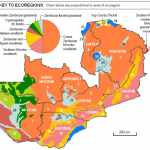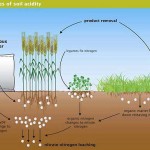SOIL ACID OR ALKALINE
Note: Sandy soils are usually Alkaline so you have to add organic material to enrich the soil.
- Ecoregions of Zambia
- It is rare that you would have too much acid in sandy soils
ACIDIC SOIL
–Slightly sour. Because acids are produced when organic matter decays, adding organic matter will increase acidity in your soil. They become increasingly sour as humus is worked in and chemicals are leached out.
–Determine soil acidity before you plant. Acidity is measured by pH, A pH of 7 is neutral; any number below is acid and any number above is alkaline. Check the pH of your soil with a home test kit available in garden supply stores or possibly your Ministry of Agriculture can provide information on testing and sampling.
–For a quick and easy soil test, wet a soil sample and add a pinch of baking soda. If the mix fizzes, the soil may be too acidic for most garden plants and vegetables.
–To each its own. Most garden plants prefer slightly acidic soil with a pH between 6 and 6.5. This includes such fruits, vegetables and flowers as apples and raspberries, beans and peas, and pansies and delphiniums. But other plants like more acid. Rhododendrons and azaleas prefer soils with a pH of 4.5 to 6.0. Potatoes grow well in soils with pH <5.5. Blueberries and cranberries grow well in even more acidic soils (<4.5) –To lower acidity in a garden soil, apply 1 to 5 kg of dolomitic limestone per 9 m2 ( 2 ½-10 lb per 100ft2) of soil, depending on the soil type, a heavy clay soil will require more amendment than a sandy soil. To raise the pH still higher til the limestone into the top 15cm (6in.) of soil.
-Ashes from your fire or wood burning stove can also “sweeten” the soil. In other words take away the “sour” of the acidic soil. Sandy soils which are already alkaline, will become more alkaline by adding ash. Spread 2.5 to 5kg per 9m2 (5-10lb per 100ft2) to raise the pH by one unit.
–In regions with high rainfall, soils acidify more quickly as calcium leaches through the soil. Even if pH is at the right level, sprinkle the soil with limestone, which will slowly work its way downward.
ALKALINE SOIL
–Test soil with cider vinegar. Add a few drops to a soil sample. If it fizzes, the soil is alkaline. Or pick up a home test kit.
–Reduce alkalinity by adding acidic materials such as compost (hopefully that you have made), sulfur, or aluminum sulphate to your soil. To lower the pH by one unit, add 2.5kg (5lbs) of peat moss, 350g to 1kg (3/4-21/2 lb) of sulfur or 2.5 to 7kg (5-15lbs) of aluminum sulphate per 9m2 (100ft2). Use the smaller amounts of additives in sandy soils and progressively larger amounts in heavier soils.
–Improving drainage may help educe alkalinity by allowing water to wash through and carry away alkaline salts. Put plenty of dead leaves, compost or other organic matter into the bottom of planting holes.
-Coffee grounds help reduce alkalinity too. Dig a good helping into the soil.
-Blanketing the ground with an organic mulch prevents surface evaporation of water and the buildup of alkaline salts so this is good for sandy soils. Use straw or dead leaves.
-Make the best of it. Instead of acidifying your soil, consider growing plants that like it alkaline. Desirable flowers in this category include the Madonna lily, purple cone flower, phlox, and candytuff. Alkaline loving shrubs and trees include lilac, peashrub, juniper, peach, hawthorne and Russian Olive. . Many farm crops including sugar beets, cotton, kale, garden peas, and many grains and grasses grow well in alkaline soil (>7.5).
-Yellowing citrus leaves may indicate that the soil is too cold or alkaline. To remedy, try adding 2.5ml.(1/2 tsp) of vinegar to every 1 L( 1 qt) of water that you give your plants.



